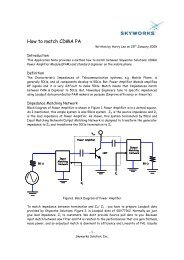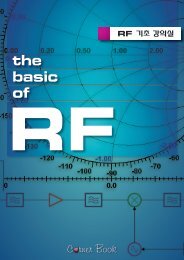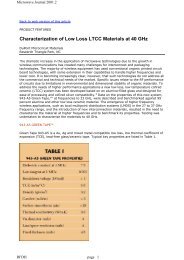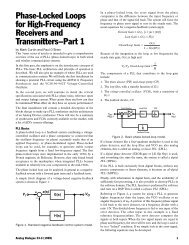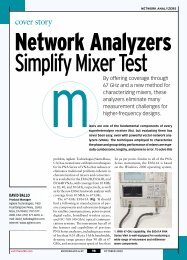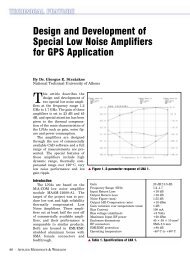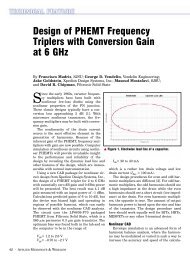Mathcad - ee217projtodonew2.mcd
Mathcad - ee217projtodonew2.mcd
Mathcad - ee217projtodonew2.mcd
You also want an ePaper? Increase the reach of your titles
YUMPU automatically turns print PDFs into web optimized ePapers that Google loves.
Noise Correlation<br />
Except in special cases, the optimal noise source impedance will be different from the optimal<br />
power source impedance. Thus, when using the optimal noise source impedance, the power<br />
gain will not be maximized. On the other hand lower power gain will increase the significance of<br />
the noise from later stages on the noise figure of the system. Thus a tradeoff exists between the<br />
optimal noise source impedance and optimal power source impedance for minimum overall<br />
system noise figure. The optimal source impedance for minimum system noise figure can be<br />
found by including the noise of the following stages, such as the mixer, in the optimal noise<br />
source impedance calculation. In many optimal source impedance calculations, other sources of<br />
noise are also neglected. The noise sources to be included in the source impedance calculation<br />
are noise from the bias source, bonding pad series resistance, series resistance of inductor<br />
degeneration from bond wires and especially from low-Q on-chip spiral inductors. The series<br />
resistance of these spirals tend to increase optimal noise source impedance, when they are used<br />
for emitter degneration of common emitter and common source amplifiers.<br />
To find the noise gains, a load impedance is assumed, which will in turn affect the gains and the<br />
optimal noise source impedance. The optimal load impedance for maximum power transfer is a<br />
good guess for the load impedance. It becomes a better guess as the noise of following stages is<br />
increased. Once the optimal source impedance is found using a guess for the load impedance, the<br />
load impedance for maximum power transfer should be recalculated from the complex conjugate of<br />
the output impedance of the device with the optimal system noise source impedance.<br />
Thus the steps for finding optimal system noise source impedance are as follows:<br />
1. Find S parameters of the circuit directly or indirectly by finding the Y<br />
parameters of the device directly.<br />
2. Find the optimal load and source impedance with the calculated S<br />
parameters.<br />
3. Find the gains of all noise sources and an input voltage source to the output<br />
with a zero source impedance. Include all noise source gains, including the<br />
noise of following stages and bias noise.<br />
4. Find the gains of all noise sources and an input current source to the output<br />
with a infinite source impedance.<br />
5. Use the gains to find the input referred equivalent voltage and noise sources<br />
and the correlation impedance.<br />
6. Use the equivalent voltage and current noise sources to find the equivalent<br />
series and parallel noise resistances.<br />
7. Use the correlation impedance and noise resistances to find the optimal<br />
source impedance.<br />
8. Recalculate desired output impedance given the optimal system noise<br />
source impedance.<br />
.<br />
I<br />
VI conj N, I C , s r b ( N) Z e ( N,<br />
s) . 2.<br />
C<br />
q. r b ( N ) Z e ( N,<br />
s) Z π N, I C , s<br />
β 0<br />
+<br />
VI conj N, I C , s = 0 W Hz<br />
r b ( N ) β N, I C , s 1 . Z e ( N,<br />
s)<br />
Z π N, I C , s<br />
.<br />
2q . I C<br />
β N, I C , s<br />
4k . . 1<br />
Temp.<br />
R L N, I C , s<br />
.<br />
β N, I C , s<br />
2<br />
2<br />
...






